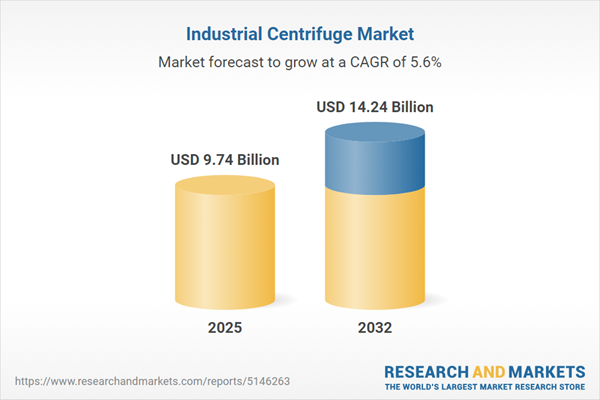Speak directly to the analyst to clarify any post sales queries you may have.
The industrial centrifuge market is evolving rapidly as technological innovation and operational demands drive new standards for process optimization worldwide. Businesses across manufacturing, chemical, pharmaceutical, mining, and food sectors are leveraging advanced centrifugation systems to streamline separation processes, improve yields, and manage complex regulatory requirements.
Market Snapshot: Industrial Centrifuge Market Growth and Opportunity
The industrial centrifuge market grew from USD 9.24 billion in 2024 to USD 9.74 billion in 2025 and is projected to reach USD 14.24 billion by 2032, reflecting a CAGR of 5.55%. Growth is being shaped by rising automation, stringent environmental policies, and increased investment in process industries across global regions. Key drivers include enhanced efficiency demands, digital monitoring adoption, and evolving end-user requirements—establishing centrifugation as a critical asset for operational excellence.
Scope & Segmentation
- Type: Decanter centrifuges (horizontal and vertical), disk stack centrifuges (manual cleaning and self-cleaning), pusher centrifuges, tubular bowl centrifuges
- Application: Chemical processes (inorganic and organic), food and beverage (beverages, dairy products), mining and minerals (coal dewatering, mineral processing), pharmaceuticals (biotechnology, formulation), wastewater treatment (industrial, municipal)
- Material Separation: Gas-solid, liquid-liquid (emulsion separation, solvent extraction), solid-liquid (clarification, filtration), solid-solid
- Speed: High speed, low speed, ultra-high speed centrifuges
- Regions: Americas (United States, Canada, Mexico, Brazil, Argentina, Chile, Colombia, Peru), Europe, Middle East & Africa (United Kingdom, Germany, France, Russia, Italy, Spain, Netherlands, Sweden, Poland, Switzerland, United Arab Emirates, Saudi Arabia, Qatar, Turkey, Israel, South Africa, Nigeria, Egypt, Kenya), Asia-Pacific (China, India, Japan, Australia, South Korea, Indonesia, Thailand, Malaysia, Singapore, Taiwan)
- Key Companies: Alfa Laval AB, GEA Group Aktiengesellschaft, ANDRITZ AG, SPX FLOW Inc., Flottweg SE, Pieralisi S.p.A., Hiller GmbH, Royal Duyvis Wiener B.V., Ashbrook Simon-Hartley Inc., Deister Machine Company Inc.
Key Takeaways
- Technological advancements in mechanical design, materials science, and control systems are redefining centrifuge performance and reliability in demanding industrial settings.
- Rising adoption of digital monitoring, predictive analytics, and remote diagnostics is driving process visibility, reducing downtime, and streamlining maintenance.
- Material innovations—such as ceramic-coated rotors and polymer composites—are extending equipment life and advancing application in corrosive and high-throughput environments.
- Manufacturers and end users are prioritizing modular system architectures and interchangeable subassemblies to accelerate installation and mitigate supply disruptions.
- Sustainability goals are prompting greater use of centrifuges for resource recovery, waste minimization, and extraction of valuable byproducts from effluents in circular process models.
- Nuanced regional trends demand tailored strategies and localized service models, as regulatory, economic, and industrial pressures vary significantly across markets.
Tariff Impact: Navigating U.S. Policy Shifts
Recent U.S. tariffs on centrifuge components and raw materials have heightened capital expenditures and prompted industry players to review sourcing arrangements. Manufacturers are responding by expanding regional production, diversifying supply chains, and adopting modular product designs to enhance flexibility and reduce risk exposure. Agile procurement and contract negotiations are essential for maintaining competitiveness amid policy fluctuations.
Methodology & Data Sources
This report is grounded in rigorous research, integrating primary interviews with equipment engineers, procurement specialists, and operations managers, alongside extensive secondary analysis of peer-reviewed journals, white papers, and industry documents. Analytical frameworks such as Porter's Five Forces and SWOT have been adapted to the market, with findings validated by triangulation and ongoing peer review from industry experts.
Why This Report Matters
- Delivers actionable insights for senior executives to optimize capital allocation, reduce operational risk, and maximize asset productivity within the industrial centrifuge market.
- Enables decision-makers to benchmark against leading market practices and select the right equipment for each separation challenge across varied applications and geographies.
- Supports strategic planning for future growth by illuminating key market trends, technology adoption drivers, and the evolving regulatory landscape.
Conclusion
Industrial centrifuge technology is positioned to address emerging processing and sustainability challenges across the value chain. Forward-thinking organizations that invest in innovation, collaboration, and adaptability will strengthen their market position as global dynamics continue to shift.
Additional Product Information:
- Purchase of this report includes 1 year online access with quarterly updates.
- This report can be updated on request. Please contact our Customer Experience team using the Ask a Question widget on our website.
Table of Contents
3. Executive Summary
4. Market Overview
7. Cumulative Impact of Artificial Intelligence 2025
Companies Mentioned
The companies profiled in this Industrial Centrifuge market report include:- Alfa Laval AB
- GEA Group Aktiengesellschaft
- ANDRITZ AG
- SPX FLOW, Inc.
- Flottweg SE
- Pieralisi S.p.A.
- Hiller GmbH
- Royal Duyvis Wiener B.V.
- Ashbrook Simon-Hartley, Inc.
- Deister Machine Company, Inc.
Table Information
| Report Attribute | Details |
|---|---|
| No. of Pages | 181 |
| Published | November 2025 |
| Forecast Period | 2025 - 2032 |
| Estimated Market Value ( USD | $ 9.74 Billion |
| Forecasted Market Value ( USD | $ 14.24 Billion |
| Compound Annual Growth Rate | 5.5% |
| Regions Covered | Global |
| No. of Companies Mentioned | 11 |









